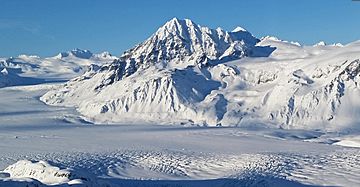Double Peak (Alaska) facts for kids
Quick facts for kids Double Peak |
|
|---|---|

Double Peak, southeast aspect
|
|
| Highest point | |
| Elevation | 6,818 ft (2,078 m) |
| Prominence | 4,610 ft (1,410 m) |
| Isolation | 15.8 mi (25.4 km) |
| Parent peak | Redoubt Volcano (10,197 ft) |
| Geography | |
| Location | Lake Clark National Park Kenai Peninsula Borough Alaska, United States |
| Parent range | Chigmit Mountains Aleutian Range |
| Topo map | USGS Kenai C-7 |
| Climbing | |
| First ascent | 1973 |
Double Peak is a tall mountain in Alaska, standing at 6,818 feet (2,078 meters) high. It is located in Lake Clark National Park and Preserve. This peak is part of the Chigmit Mountains, which are a section of the larger Aleutian Range.
Double Peak is special because it is the highest non-volcanic mountain in the Chigmit Mountains. It ranks as the third-highest peak overall in that range. The mountain sits just north of a large ice formation called Double Glacier. It is about 100 miles (161 km) west-southwest of Anchorage. The nearest higher peak is Redoubt Volcano, about 18 miles (29 km) away.
Even though it's not super high compared to some mountains, Double Peak rises dramatically from the sea. It starts near Cook Inlet and goes up quickly over about 20 miles. This makes its "relief" (how much it stands out from its surroundings) very significant. It is the 71st most prominent peak in all of Alaska.
Mountain Name and First Climb
The name "Double Peak" comes from the Double Glacier. This glacier is right next to the mountain. The United States Coast and Geodetic Survey officially named the mountain in 1912.
The very first ascent of Double Peak happened on May 19, 1973. A team of six climbers reached the top. These climbers were Steve Hackett, John Samuelson, Helmut Tschaffert, Toby Wheeler, Daniel Hurd, and Daniel Jones. They climbed the steep northwest snow face of the mountain.
If you want to see or climb Double Peak, the best time is usually from May through June. The weather during these months is most favorable.
Weather Around Double Peak
The area around Double Peak has a subarctic climate. This means it has long, cold, and snowy winters. The summers are cool.
Temperatures can drop very low, sometimes below −20 °C (or −4 °F). With the wind chill, it can feel even colder, below −30 °C (or −22 °F). All the snow and ice that melts from the mountain flows into the Big River, which then drains into Cook Inlet.


